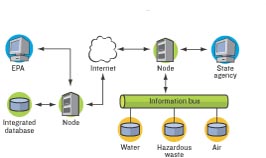Network to give EPA clearer picture

Connecting state and local government leaders
The Environmental Protection Agency receives seven major quarterly reports from state agencies and private facilities on topics ranging from drinking water to hazardous waste.
The Environmental Protection Agency receives seven major quarterly reports from state agencies and private facilities on topics ranging from drinking water to hazardous waste.
Collectors of this data send it to the EPA on disk or ftp it directly to the agency, which stores, maintains and analyzes the information to give the government a coast-to-coast view of the nation's environment.
But often EPA's picture is less than complete because state agencies do not have the resources to input all their reports, EPA CIO Kim Nelson said.
That is why Nelson is spearheading a project to improve data integrity, ease file transfer and standardize the format of the information states submit to EPA.
The agency has created a secure Web site prototype, the National Environmental Information Exchange Network, that seven states'Delaware, Maine, Mississippi, Nebraska, New Hampshire, New Mexico and Utah'will test this fall.
'We are creating a Web services environment,' Nelson said. 'We are certainly reducing the amount of burden placed on states and EPA, and we expect to see considerable cost savings and higher-quality data.'

EPA received small batches of data over the system last spring, Nelson said. States and private facilities sent 8,000 toxic release inventories to the agency in June using the network's beta version.
Nelson said by December 2004 states will send most data through the system.
Nelson, who worked for Pennsylvania's Environmental Protection Department for 14 years, saw firsthand the mounds of data agencies must process.
'We would receive about 60,000 reports a month and only about 25 percent were put into the system because that is all the people who did data entry could do,' she said. 'We didn't see patterns or trends, and we didn't know what problems we would be missing because we were not looking at 75 percent of the data.'
Sorting it out
The new exchange network is a fairly simple concept. States set up a node, or server, that is linked to a main database that collects all its environmental data. Using Extensible Markup Language schemas, the information is sorted into nationally agreed upon data sets.
EPA gathers the information with an automatic data call. When EPA sends out a data call, the state server recognizes the EPA server, pulls the information from its database and uploads the requested records.
'We hope this will be a seamless exchange of information,' said Dennis Burling, IT manager for the Nebraska Environmental Quality Department and state co-chairman for the exchange network project. 'The current process is complex, and any minor change causes a ripple effect through the entire process.'
Burling said most states send EPA data by building a translator application to create batch data formats so EPA's system can understand the information. Anytime EPA changes the data fields, state agencies scurry to keep up.
The network will make everything simpler because an EPA and state working group agreed to common definitions and standards on what data is collected and the XML schemas used to send the information, Burling said. 'We are trying to develop consistency in the operation and exchange of information,' he said.
Nebraska built its node for under $25,000 and received funding and contractor support from EPA.
EPA earlier this month awarded $25 million in grants to 44 states and 17 American Indian tribes to help them prepare to use the network. States are eligible to receive from $400,000 to $1 million to build or improve their reporting systems. Nelson said EPA requested another $25 million for the project for fiscal 2003.
Burling said by early November the seven-state pilot will launch protocols and standards for exchanging large sets of data with EPA.
'We are on an aggressive schedule because so many states want to build their own nodes,' Burling said. 'This small group of states agreed to take the lumps and get it right so others will not have to spend their resources in trying to do this more than once.'
NEXT STORY: State Web sites neglect the 'weakest link'




